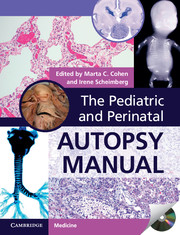Book contents
- Frontmatter
- Contents
- List of contributors
- Foreword
- Preface
- Acknowledgments
- 1 Perinatal autopsy, techniques, and classifications
- 2 Placental examination
- 3 The fetus less than 15 weeks gestation
- 4 Stillbirth and intrauterine growth restriction
- 5 Hydrops fetalis
- 6 Pathology of twinning and higher multiple pregnancy
- 7 Is this a syndrome? Patterns in genetic conditions
- 8 The metabolic disease autopsy
- 9 The abnormal heart
- 10 Central nervous system
- 11 Significant congenital abnormalities of the respiratory, digestive, and renal systems
- 12 Skeletal dysplasias
- 13 Congenital tumors
- 14 Complications of prematurity
- 15 Intrapartum and neonatal death
- 16 Sudden unexpected death in infancy
- 17 Infections and malnutrition
- 18 Role of MRI and radiology in post mortems
- 19 The forensic post mortem
- 20 Appendix tables
- Index
- References
14 - Complications of prematurity
Published online by Cambridge University Press: 05 September 2014
- Frontmatter
- Contents
- List of contributors
- Foreword
- Preface
- Acknowledgments
- 1 Perinatal autopsy, techniques, and classifications
- 2 Placental examination
- 3 The fetus less than 15 weeks gestation
- 4 Stillbirth and intrauterine growth restriction
- 5 Hydrops fetalis
- 6 Pathology of twinning and higher multiple pregnancy
- 7 Is this a syndrome? Patterns in genetic conditions
- 8 The metabolic disease autopsy
- 9 The abnormal heart
- 10 Central nervous system
- 11 Significant congenital abnormalities of the respiratory, digestive, and renal systems
- 12 Skeletal dysplasias
- 13 Congenital tumors
- 14 Complications of prematurity
- 15 Intrapartum and neonatal death
- 16 Sudden unexpected death in infancy
- 17 Infections and malnutrition
- 18 Role of MRI and radiology in post mortems
- 19 The forensic post mortem
- 20 Appendix tables
- Index
- References
Summary
Introduction
In most jurisdictions an infant is regarded as premature when delivered at fewer than 37 weeks gestation [1,2]. The proportion of babies born prematurely rather than at term is small: 18% in the United States in 2009 [3], 12% in England and Wales [4], and 7.4% in Australia [5]. But the risks to a pre-term infant are significant and those risks increase with greater prematurity. In England, Wales, and Northern Ireland, there is nearly one neonatal death per 1000 live births at term, but this rises to 204 deaths per 1000 births in babies born between 24 and 27 weeks gestation [6]. Further, especially in this latter very pre-term group, survivors display significant morbidity, including chronic respiratory disease, ultrasound-detected brain injury, and retinopathy of prematurity [7]. While there is evidence of a reducing mortality in most pre-term gestations, there are some indications that this is at the expense of increased morbidity [8]. Even late pre-term babies have a higher risk of morbidity, particularly respiratory problems and infectious diseases, than term infants [9].
Premature birth is spontaneous and without a specific recognized cause in some 31–51% of cases, but there is an increased risk associated with multiple pregnancy (12–28%), premature membrane rupture (6–40%), cervical incompetence (8–9%), and antepartum hemorrhage (6–9%). Associated ascending infection may be a significant factor in some of these conditions [10]. An obstetric decision to deliver early may be influenced by a number of additional factors, such as fetal growth restriction and maternal hypertension.
- Type
- Chapter
- Information
- The Pediatric and Perinatal Autopsy Manual , pp. 284 - 297Publisher: Cambridge University PressPrint publication year: 2000
References
- 1
- Cited by



